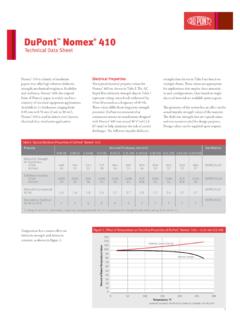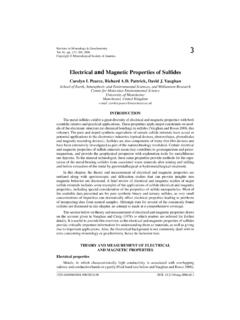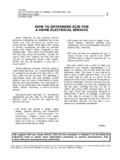Transcription of SAFETY BY DESIGN: SOLID INSULATED …
1 SAFETY BY DESIGN: SOLID INSULATED technologies CHALLENGE THE USE OF SF6 IN MEDIUM-VOLTAGE SWITCHGEAR Copyright Material IEEE Paper No. ESW2015-03 David B. Durocher Senior Member, IEEE Global Industry Manager Eaton Corporation 26850 SW Kinsman Road Wilsonville, OR 97070 USA Dr. Mario Haim Member, IEEE Director R&D/Portfolio Management Eaton Corporation Europalaan 202 Hengelo,Netherlands 7559 SC Lawrence T. Connor Member, IEEE Global Application Specialist Eaton Corporation 1000 Cherrington Parkway Moon Township, PA 15108 USA Johan de Jong Member, IEEE Portfolio Manager, MV Systems Eaton Corporation Europalaan 202 Hengelo, Netherlands 7559 SC Abstract - Much information has been disseminated regarding the environmental impact and workplace SAFETY of medium-voltage gas INSULATED switchgear (GIS) assemblies installed in industrial facilities.
2 This paper will present some of the common myths and technical documentation available regarding circuit breakers utilizing Sulfur Hexafluoride (SF6) gas interrupters and switchgear using this gas for insulation. Focus will be on regulatory, operational and total life-cycle costs associated with this technology and SAFETY from the perspective of not just the electrical workplace but the impact of SF6 designs on the business and the impact on the planet. Although SF6 designs have been commercially available and have functioned reliably for the past 30 years, new available technologies have emerged that offer comparable footprints and superior performance without adding the business risk of containment, required SAFETY data sheet documentation and end of life disposal challenges presented by legacy SF6 based designs.
3 A total ownership cost analysis will be presented including estimated purchase cost, operation and maintenance cost, regulatory compliance cost and dismantling-recycling cost of SF6 versus the next generation SAFETY by design switchgear offering. Index Terms Environmental Impact, Gas INSULATED Switchgear (GIS), Sulfur Hexafluoride (SF6), Global Warming, Greenhouse Gases, Air INSULATED Switchgear (AIS), Medium Voltage Circuit Breaker, Vacuum Interrupter. I. INTRODUCTION Over the course of the past 100 years, medium-voltage switchgear has served as the primary switching and protection platform for virtually every global industry. Designs based on application of oil design circuit breakers in the early 1900 s gave way to air magnetic circuit breaker interrupters and air INSULATED bus compartments which were popular in the 1950 s and 1960 s.
4 Later, new vacuum circuit breakers became available which, over the course of time, delivered higher interrupting ratings with the advantages of a smaller size and a contained interruption inside a vacuum sealed chamber. Around this same time, SF6 interrupters became commercially available with the advantage of both application at higher voltages and higher interrupting ratings. This natural progression took place as concerns escalated regarding environmental hazards associated with poly-chlorinated biphenyls (PCBs) that were found in insulating oil used in the previous generation of breakers. Many medium-voltage and high-voltage utility systems applied at 66 kilo-volts (kV) and above featured SF6 interruption.
5 Power systems operating at these voltages today are almost exclusively based on SF6 as other switching technologies are generally not available at these ratings within the same dimensions. In addition to SF6 circuit breakers, designs based on SF6 as an insulating medium also became available and are today applied in many types of power systems. Designs of Gas INSULATED Switchgear (GIS) offer assembly bus bars that are enclosed in a sealed chamber with the gas serving as an insulator between conductor phases, effectively replacing air. Industry design and test standards for medium-voltage switchgear and circuit breakers whether they be air INSULATED , gas INSULATED , SF6 or vacuum interrupters, tend to conform to one of only two regional standards.
6 In North America, the American National Standards Institute/Institute of Electrical & Electronics Engineers (ANSI/IEEE) Standard Standard for Metal-Clad Switchgear with rated maximum voltage levels from kV to 38 kV applies. A companion standard ANSI/IEEE Standard Guide for Testing Metal-Enclosed Switchgear Rated Up to 38 kV for Internal PRESENTED AT THE 2015 IEEE IAS ELECTRICAL SAFETY WORKSHOP, LOUISVILLE, KY: IEEE 2015 - PERSONAL USE OF THIS MATERIAL IS PERMITTED. Arcing Faults defines a more robust design with specific tested ratings to withstand internal arcing faults. Outside of North America, the International Electrotechnical Commission Standard IEC 62271-200 AC Metal-Enclosed Switchgear and Controlgear for rated voltages above 1 kV and up to and including 52 kV applies.
7 This standard includes testing of the switchgear assembly based on ratings to withstand internal arcing faults. Today s industry standards for medium-voltage circuit breakers do not specifically delineate or define the method of arc interruption, so manufacturers are free to select from multiple technologies to suit the needs of their customers. Due to cost and rating requirement, switchgear systems applied at a voltage class of 15 kV and below have generally been based on vacuum interruption technology. System voltages above 15 kV, up to the voltage limitations as defined by the standards, have tended more toward SF6 designs. In recent years, there has been a distinct shift away from SF6 for a host of both technical and commercial reasons which will be described in this paper.
8 II. TRENDS IN POWER SYSTEMS DESIGN Several of today s process industries require very high energy intensity. Processes such as aluminum smelters, steel rolling mills and oil refineries require power systems that are both large in scale and designed with a high degree of reliability. Increased source Mega-Volt Amperes (MVA) requirements for industrial power systems are driving systems toward higher distribution voltages to distribute power across a facility. As an example, Fig. 1 shows an abbreviated single line diagram for a planned grassroots nickel mine & smelter facility planned for construction in Central America. Note that a total of 22 MVA of connected loads are shown. This represents only a portion of the total connected 130 MVA electrical load required for this new manufacturing facility.
9 Note also that there is application for only two voltages in the defined medium-voltage systems: one being kV, and the other kV. In this example, the grassroots facility planned for construction in Central America utilizes a kV primary voltage. For ANSI/NEMA markets in North America, test and design standards for this voltage class are typically based on 38 kVl. In IEC markets 36 kV voltage class applies and in China, kV is the most typical in this nominal voltage. A significant consideration in this example is that the design voltages selected to deliver power across the entire site represent a fairly high medium-voltage at kV. The higher voltage selection results in smaller conductors, less losses and lower costs.
10 Then below kV, the next system voltage is kV used to service large motor loads. The only other 3-phase system voltage required for this site is a 3-phase low-voltage used for smaller motors and auxiliary loads such as lighting transformers. In the case of this project, the applied low-voltage was 480 Vac. Traditional power systems for a site such as this might typically include a third medium voltage such as 27 kV, 15 kV or for IEC systems 11 kV. Although a third system voltage may be suitable for smaller electrical systems at perhaps 30 MVA and below, there is a trend toward power systems design based on higher voltages. The same holds true for switchgear interrupting ratings. Assuming the total 130 MVA source for this design was rated at a nominal impedance of , the kV switchgear interrupting rating would need to be 130 MVA/( X kV) = kA.


















